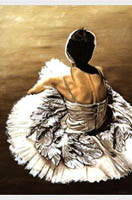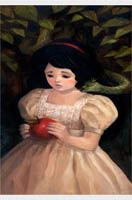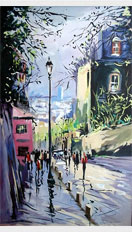Oil painting -> List of Painters -> Aleksander Orlowski
EARLY DAYS:
Aleksander Orłowski was a Polish artist, born in 1777 in the town of Vilnius. He was a noted portraitist and landscape painter and is considered to be one of the most important figures in Polish Romanticism. He is known for his large-scale history paintings, landscapes and portraits, which were displayed in various cities throughout Europe.
Orłowski was born into a family of artisans and spent his early years learning the skills of painting and drawing. He received his first formal training in the studio of Jan Piotr Norblin, an important Polish history painter. While under Norblin's tutelage, Orłowski learned the techniques of composition and colouring, as well as the art of portraiture. He also became familiar with the works of other famous masters, such as Rembrandt, Rubens, and Watteau.
In 1799, Orłowski moved to Warsaw, where he established a painting studio of his own and began to produce portraits and landscapes. He soon attracted the attention of the Polish aristocracy and was commissioned to paint a series of portraits of prominent members of society. The success of these works brought Orłowski to the attention of the royal court and he was appointed court painter to King Stanislaus Augustus Poniatowski.
Orłowski was soon commissioned to produce a large-scale history painting, which he completed in 1804. The painting, entitled "The Battle of Racławice", depicted the victory of Polish forces over their Russian enemies in 1794, and is one of the most famous works of Polish Romanticism.
Orłowski's success in history painting led to further commissions, and he was soon producing works for the royal court, churches, and private collectors. His paintings were highly acclaimed throughout Europe, and he became internationally renowned for his large-scale history paintings and portraits.
In 1817, Orłowski was asked to join the faculty of the Academy of Fine Arts in Warsaw, where he taught until 1827. His students included many of the leading Polish artists of the 19th century, such as Piotr Michalowski, Aleksander Kotsis, and Jan Matejko.
Orłowski died in 1832 at the age of 55, but his legacy lives on in his works, which can be seen in various cities across Europe. He is remembered as one of the most important figures in Polish Romanticism and his influence can still be seen in the works of modern Polish artists.

Personal Details:
CAREER:
Orłowski was a pupil of Jan Piotr Norblin and developed his own style during his studies in Rome. His works from the period often depicted historical and religious scenes, and he became known for his ability to capture the spirit of the times in his paintings. He was also skilled in engraving, and his woodcut prints of the 18th century were particularly popular.
Orłowski's fame spread beyond Poland and he was invited to Paris by Napoleon I. When the French Emperor commissioned him to paint The Battle of Austerlitz, Orłowski created an epic painting that is still considered one of the greatest battle paintings of all time.
Orłowski spent much of the 1820s in Italy, where he was commissioned to paint the ceiling of the Royal Palace in Naples. He was also commissioned to paint the interior of the Royal Palace in Warsaw, which was to be the new residence of the Polish King. His works from this period include the altarpiece of St. John the Baptist in St. Peter's Basilica in Rome.
Orłowski's career reached its peak in the early 1830s, when he was commissioned to paint the frescoes in the newly restored Royal Chapel of the Royal Castle in Warsaw. This was the first major fresco project in Poland, and Orłowski produced some of his most memorable paintings during this time.
Orłowski was a master of both oil painting and fresco painting, and his works are still highly regarded today. He was an important influence on the development of Polish art, and his works remain popular among collectors. He is remembered as one of the leading artists of Poland's Golden Age, and his legacy is still evident in the art of Poland today.







